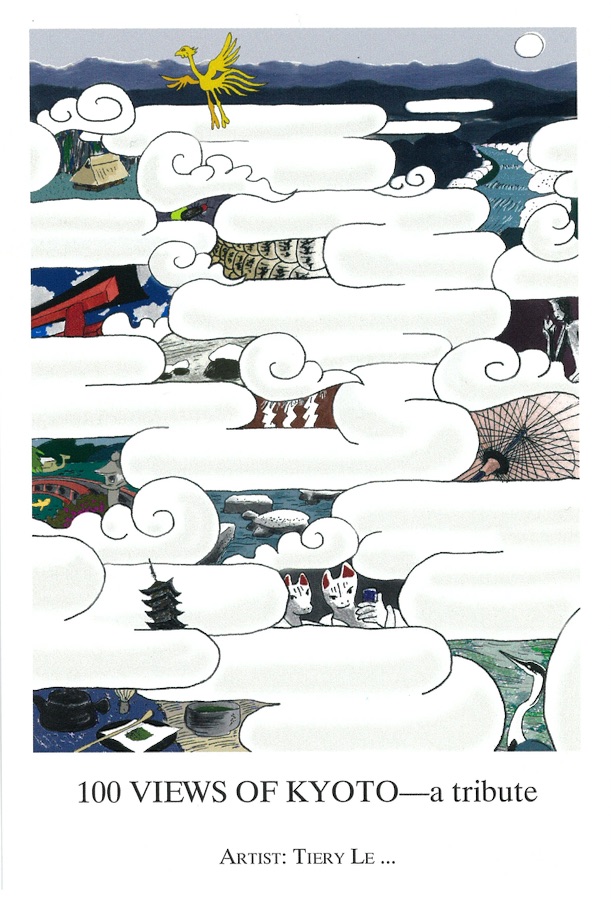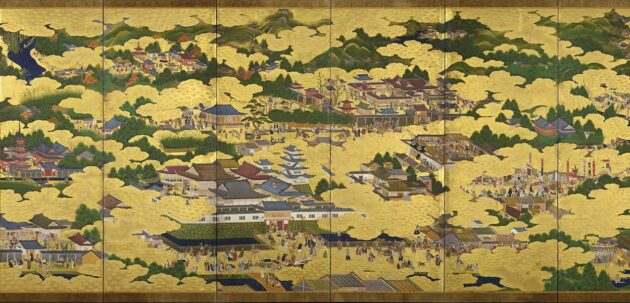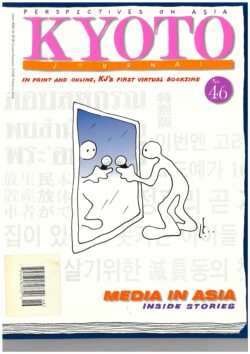Readers who ordered KJ100 received various selected bonus inserts (as a way of celebrating this centennial issue); among them was a unique, specially-designed postcard by local artist and long-time KJ contributor Tiery Le,..

This view is a quirky contemporary Tiery riff on the rakuchu rakugai zu screen paintings of feudal-era Kyoto, those richly detailed bird’s-eye perspectives that gaze down through golden clouds to illuminate key features.
While it’s common knowledge that old Kyoto (Heian-kyo) was modeled on China’s Tang-dynasty capital Chang’an (a precursor to present-day Xian), the derivation of “rakuchu rakugai” is not so well known. Long ago, the western half of Heian-kyo was called “Choan-jo” (Chang’an Castle) and the eastern half, “Rakuyo-jo” (the Castle of Luoyang, the T’ang Dynasty’s “eastern capital”). The western side of Kyoto remained mostly undeveloped, and eastern Kyoto boomed. Thus “Rakuyo” came to signify the capital as a whole, a name eventually abbreviated to “Raku.” in the late 16th century Toyotomi Hideyoshi encircled the built-up area of east-side Kyoto with his Odoi, a defensive barrier of earthwork walls and moats; the area inside the Odoi became known as “Rakuchu” and outside it, as “Rakugai.”

This classic and densely-populated rakuchu rakugai zu screen painting, centered on Nijo Castle (plus six more of its 12 panels, looking to the east side of the Kamogawa) can be encountered in superb close-up detail here. Look for the shifty-eyed gift-bearing European merchant delegation at the main gate, seeking an audience with the Shogun…

Tiery’s incisive graphics were a defining element in KJ 46, our ‘Media in Asia’ issue (2001), edited by Stewart Wachs, and also appeared in KJ 61 (2005), illustrating a lead article by Tawada Yoko, ‘Is Europe Western?’ One of his paintings, ‘Awe,’ was featured more recently in KJ 94 (2019), in a section appropriately titled ‘Inspired by Kyoto – Foreign Artists in the Ancient Capital.”
Below, a more recent political comment:


Author
K.J. Tokubetsu
Author's Bio
Tiery Le,.. studied at L’Ecole Nationale Superieure d’Art de Paris-Cergy and the University of Massachusetts Amherst before arriving in Japan in 1999 – on 9.9.99 at 9:09 (and 9 sec.) – to be precise. Since then he has worked as an artist and designer, raised a family, and more recently, found another creative niche as a well-recommended specialized cycling tour guide here on the Chang’an-inspired street grid of Kyoto.
Credits
Postcard and KJ cover by Tiery Le,..


